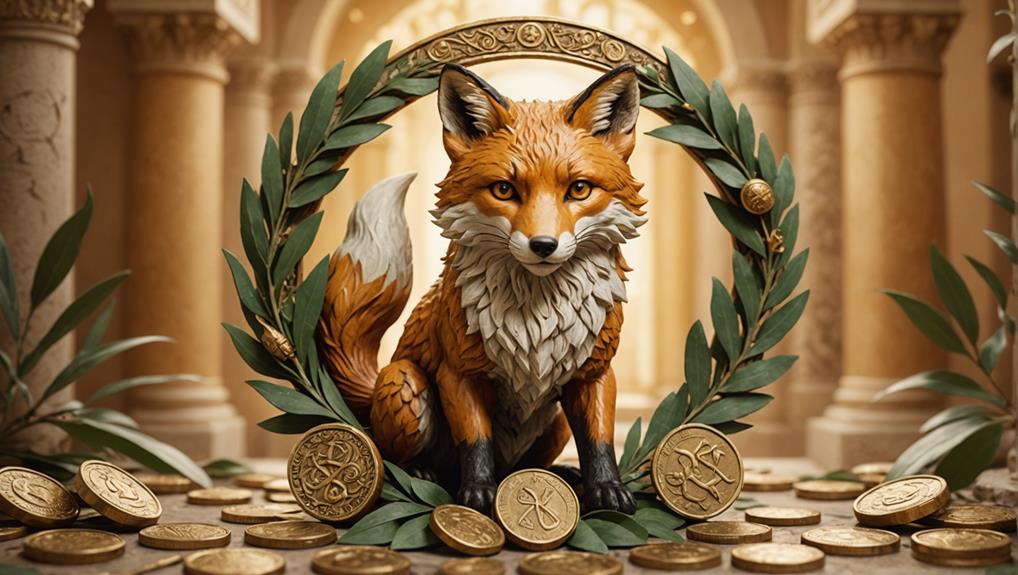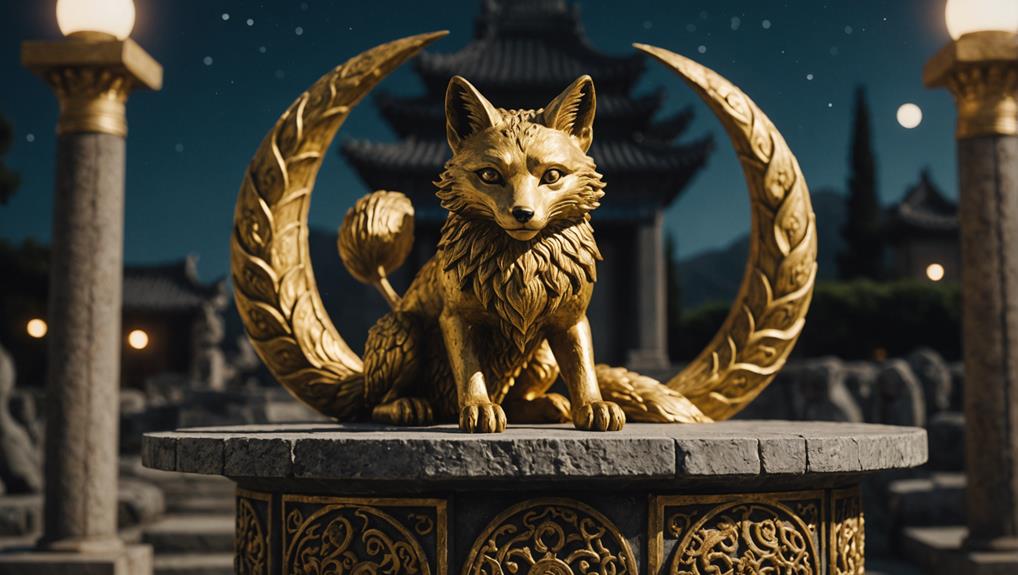As you explore the symbolism of fox imagery in ancient cultures, you'll discover that these clever creatures embodied a range of attributes, from cleverness and transformation to tricksterism and adaptability. In ancient art, foxes were depicted as musicians, guardians, and mystical beings, reflecting their multifaceted nature. In Mesopotamian lore, they symbolized wisdom and cunning, while in Greek and Roman mythology, they represented strategic thinking and intelligence. Across cultures, foxes were associated with transformation, adaptability, and duality, making them a fascinating symbol of human complexity – and as you continue on this journey, you'll uncover even more intriguing facets of the fox's symbolic significance.
Contents
Fox Imagery in Ancient Art
In the realm of ancient art, the fox emerges as a fascinating and multifaceted creature, weaving its way through various cultures and civilizations. As you explore the symbolism of fox imagery, you'll discover that this cunning animal played diverse roles across cultures.
In ancient Egyptian art, foxes were depicted as musicians and guardians, often associated with the god Set, representing chaos and disorder. Meanwhile, Greek pottery frequently illustrated foxes in hunting scenes, symbolizing cleverness and strategy, aligning with their role as cunning animals in various myths.
Roman mosaics demonstrated the fox's presence in domestic settings, emphasizing its association with resourcefulness and adaptability in the human habitat. In Chinese art, particularly during the Tang Dynasty, foxes were often represented as mystical beings, embodying themes of transformation and deceptive seduction.
As a sacred animal, the fox's symbolism across cultures highlights its cleverness, transformation, and trickster nature, making it a compelling and intriguing creature in ancient art.
The Fox in Mesopotamian Lore
As you venture into the realm of Mesopotamian lore, you'll discover that the fox takes on a revered role, symbolizing wisdom and cunning in the eyes of the ancient Mesopotamians. This cunning nature is reflected in their association with the goddess Ninhursag, highlighting their importance in fertility and agricultural aspects of society.
The fox as a symbol is woven into myths, often depicted as shrewd creatures navigating both the natural and spiritual worlds. Their connection to the Pleiades constellation underscores their role in shamanistic practices, guiding shamans through the underworld.
In creation myths, foxes collaborate with other animals, like Coyote, to form the world, emphasizing their transformative powers. Through these narratives, Mesopotamian culture attributes intelligence and resourcefulness to foxes, solidifying their role in ancient mythological storytelling.
This profound understanding of the nature of life is rooted in the interplay of light and shadow, echoing the complexities found in European folklore. As you delve deeper into Mesopotamian lore, you'll find that the fox's symbolism continues to captivate, offering a glimpse into the rich tapestry of myth and legend.
Greek and Roman Mythological Depictions

Venture into the realm of Greek and Roman mythology, and you'll stumble upon a multifaceted depiction of the fox, where its cunning nature takes center stage. You'll discover that the fox was more than just a sly creature; it was a symbol of protection, guardianship, and adaptability.
Here are three key aspects of the fox's depiction in Greek and Roman mythology:
- Cunning and Trickster Nature: The fox was often portrayed as a clever trickster, outsmarting larger and more powerful adversaries, reflecting the qualities of intelligence and adaptability.
- Guardianship and Fertility: In Greek mythology, the fox was associated with the vine and fertility, symbolizing protection and guardianship, particularly connected to Dionysus, the god of wine.
- Moral Lessons and Strategy: Roman literature depicted foxes as figures of charm and mischief, reinforcing their dual nature as both cunning beings and symbols of strategy in human behavior, as seen in fables like "The Fox and the Grapes".
Through these depictions, you'll see that the fox was more than just a clever animal; it was a symbol of human nature, with all its complexities and contradictions.
Foxes in East Asian Traditions
You've explored the multifaceted depiction of foxes in Greek and Roman mythology, now let's uncover the fascinating realm of East Asian traditions, where foxes take on a life of their own as powerful spirits.
In these cultures, the fox spirit is revered for its magical abilities, cunning nature, and adaptability. In Japan, the Kitsune embodies both benevolence and mischief, while in Chinese folklore, the Huli Jing can transform into alluring women, but sometimes drains life energy.
In Korea, the Kumiho is a nine-tailed creature that can transform into a beautiful woman, but often has a predatory nature. Vietnamese mythology features the Cào, a trickster figure capable of shape-shifting and leading people astray.
These depictions highlight the complexities of human interactions with foxes, showcasing their ability to change and navigate the mysteries that lie beyond.
With their quick wit and cunning nature, foxes in East Asian traditions embody a duality of nature, serving both as protective spirits and representing danger.
The Spiritual Significance of Foxes in Indigenous Cultures

In Indigenous cultures, your spiritual journey is often guided by the cunning and adaptable fox, a revered totem that embodies the vital traits necessary for survival in challenging environments. This revered creature serves as a spiritual guide, teaching you to navigate life's complexities with intelligence, cunning, and adaptability.
Here are three ways the fox's symbolism manifests in Indigenous cultures:
- Creator figure: In Native American mythology, the fox is often portrayed as a creator figure, credited with shaping the Earth and humanity, emphasizing its role in the natural order and the intricacies of life.
- Tricksters: Indigenous narratives frequently depict foxes as tricksters, exemplifying the duality of mischief and wisdom, encouraging communities to reflect on moral lessons and the complexities of human nature through these allegorical tales.
- Seer-shaman: The Inca civilization revered the fox as a seer-shaman, linking it to the Pleiades constellation and associating it with transformative powers and creation myths alongside other animals like Coyote.
Through these representations, the fox's spiritual significance in Indigenous cultures encourages you to develop the cunning and adaptability needed to thrive in an ever-changing world, while also learning valuable moral lessons about the natural order and human nature.
Final Thoughts
As you've explored the symbolism of fox imagery in antiquity, you've likely noticed a common thread – foxes were often seen as clever, cunning, and adaptable. But did you know that in Japan, foxes were believed to possess up to nine tails, symbolizing their growing wisdom and power? It's no wonder that foxes have captivated human imagination for centuries. Today, with over 40% of the world's fox species facing extinction, it's more important than ever to appreciate these remarkable creatures and the rich cultural heritage they've inspired.














